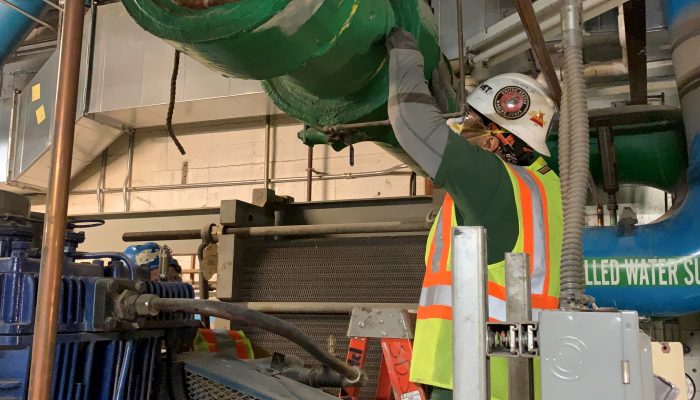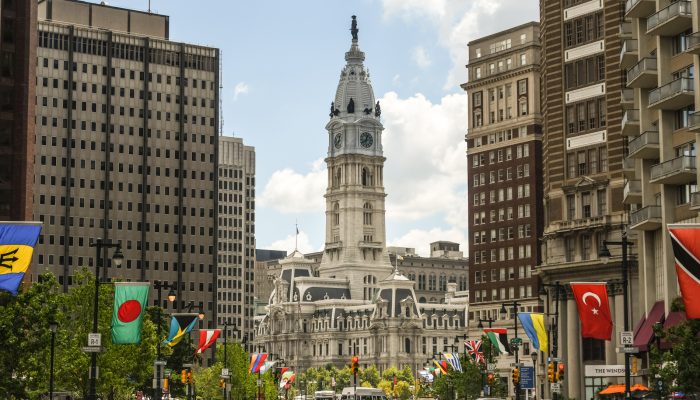The Philadelphia Museum of Art (PMA) is a cultural gem and arguably one of Philadelphia’s most iconic buildings. However, as the building approaches its hundredth anniversary, it is also one of the top five largest municipal energy users in the city. A performance contract was enacted to reduce the PMA’s energy use and bring the City closer to its energy and climate goals. This performance contract is a public-private partnership between the City of Philadelphia, the PMA, the Philadelphia Energy Authority, and Johnson Controls.
Philadelphia has set an ambitious city-wide goal of becoming carbon neutral by 2050. With building emissions comprising 72% of Philadelphia’s carbon footprint, improving their efficiency is key to reducing carbon emissions.
Performance contracting is a critical energy efficiency strategy for Philadelphia’s larger buildings, as the annual cost savings from the projects is enough to pay for the project costs over time. With its Quadplex Energy Savings Project, the City demonstrated success in realizing significant energy and cost savings at the four high energy use buildings that make up the Quadplex—City Hall, the Municipal Services Building, One Parkway Building, and the Juanita Kidd Stout Center for Criminal Justice.
The Quadplex project, completed in January 2015, saves the City $1.45 million annually. This was achieved through a mix of high payback energy conservation measures that included boiler improvements, steam pipe insulation, HVAC drives and sensors, building control systems, low-flow water fixtures, and lighting upgrades. In addition to cost savings, the facility is now easier to operate and more comfortable for workers and visitors.
With the success of the Quadplex project as a model, the City turned its eye to the PMA. Before the project began, the PMA used 16.9 million kWh of electricity, 77,000 Mlbs of steam, and 14 million gallons of water each year. To reduce annual energy and water use, the PMA project team installed new LED lighting fixtures, upgraded the heating system, and installed a new chilled water system, among other major investments.
With the completion of the project in late 2020, greenhouse gas emissions from the PMA are projected to decrease by nearly 2,400 metric tons of CO2 equivalent annually. The building is expected to save 4.8 million kWh of electricity (28% reduction), 16,000 Mlbs of steam (21% reduction), and 1.2 million gallons of water (8% reduction), for an annual cost savings of $750,000. The electricity savings alone are enough to power 437 average U.S. households for a year, and the cost savings will pay for the $11.3 million project.
All of these improvements support the City’s Municipal Energy Master Plan goals to reduce energy use by 20% and carbon emissions by 50% by 2030. In addition to the reductions in energy use, carbon emissions, and cost, the overall project created 191 jobs, with minority- and women-owned businesses performing more than 40% of the work on the project.
By reducing energy use at its own facilities, the City is leading by example. Projects like this demonstrate that all Philadelphians, including residents, businesses, and large institutions, have a role to play in reducing the city’s carbon footprint. As seen with the Quadplex and now with the PMA, greater energy efficiency saves money and reduces carbon emissions. Upgrades like LED lighting, timers, lowered set points for heating and cooling systems, and energy efficient windows are a few of the cost-effective measures all Philadelphians can take to help reach citywide goals. Learn about actions you can take to make your home more energy efficient.
Cultural institutions like the PMA have pledged to improve the environment and the lives of residents. Saving energy and reducing emissions benefits the health and economic wellbeing of all Philadelphians, and powerful public-private partnerships like the one that drove the PMA project bring unique commitments, experiences, and resources that support the shared goals of improving the city’s environment, economy, and equity.




